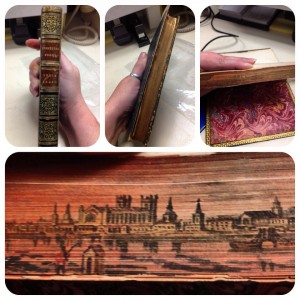By: Allyson Holliday, W.S. Hoole Library Complex Copy-Cataloger
“Old” books hold a special place in my heart as the complex copy-cataloger for the Hoole Library. I have a deep appreciation for decorative publishers’ bindings that show the artistry that has been lost with modern day mass trade publication. In January 2008, while strolling the historic streets of St. Augustine, Florida, I came across this treasure at Wolf’s Head Books, Inc.
At first glance, this copy of Enoch Arden by Alfred Tennyson, published in London by Edward Moxon & Co. in 1865, appears to be a typical 19th century leather binding with gilt accents and marbled endpapers. However, on closer examination, a hidden treasure is revealed. The edges of the book’s pages have been painted in gilt. The margins of each page have also been painted in such a way that when the book is fanned slightly, a picture of a scene emerges. A fore-edge painting! The Enoch Arden fore-edge painting is by an unknown artist. It is a depiction of a Canadian landscape – a view of Montreal from St. Helen’s Island.
The fore-edge of a book is the fourth edge – not the spine, the top, or the bottom edge, but the outside edge that a reader uses to turn the pages. In the 17th century, one of the Queen’s Binders (a group of highly skilled English bookbinders during the Restoration period) discovered that if one painted on the slight inner edges of the pages, then gilded or marbled the outside page edges, the scene would be undetectable when the book was closed, and only reveal itself when the pages were fanned slightly, creating a disappearing, re-appearing masterpiece.
I had never seen a book with a fore-edge painting! I returned to Tuscaloosa excited about my find and shared the details with our curator at that time, Clark Center. He was able to acquire this text for our Book Arts Collection which includes fine press, small press, and other examples of artists’ books. This collection supports the MFA program in the Book Arts in the School of Library and Information Studies at The University of Alabama.
The fore-edge technique was especially popular in England from the late 18th to the late 19th centuries, making Tennyson’s works good candidates for this type of art. Here is another fore-edge painting on a different edition of Enoch Arden from the Special Collections of the San Diego Public Library.
Many of the books sold today with fore-edge paintings are antiquarian volumes to which the edge paintings have been added much later. One of the most widely seen modern-day fore-edge painting artists is Martin Frost, based in the UK, who has produced countless fore-edge paintings, including many offered for sale on AbeBooks, since 1970.
Social media has recently placed an international spotlight on books with fore-edge paintings. The University of Iowa’s collection of fore-edge painting books appeared recently in the Daily Mail and received widespread attention on Twitter.
Artists like Martin Frost and the libraries across the world who hold books with fore-edge paintings are keeping the concept of the “book as art” alive. With the proliferation of paperback bindings and e-readers, reading has become more of an easy access, throw-away type of leisure activity. Books intricately decorated and adorned are historic relics of a by-gone era where the object was celebrated as much as the text inside.


One Response to Hidden artistry: fore-edge painting